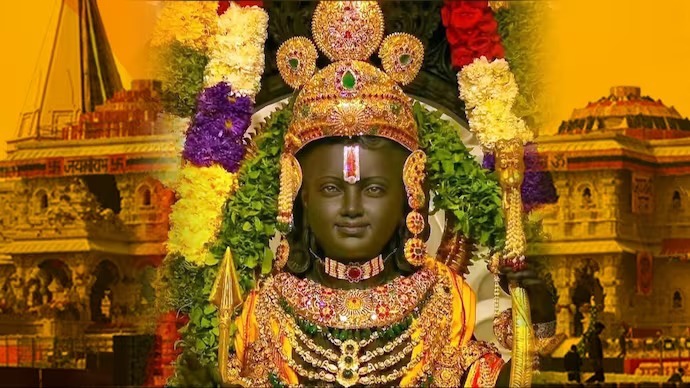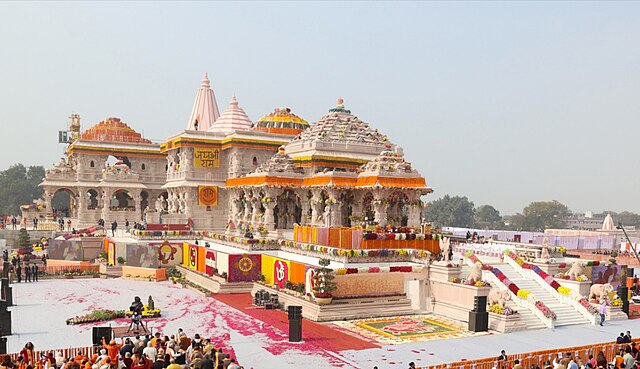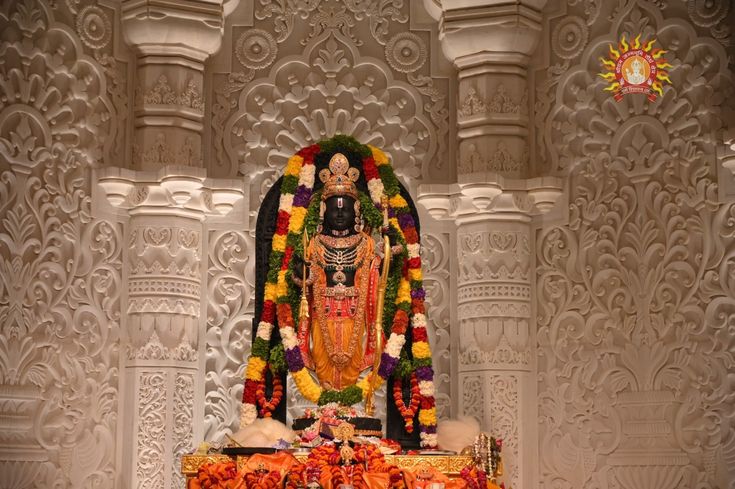
Ram Janmabhoomi , Ayodhya
Ram Janmabhoomi is the site that, according to Hindu religious beliefs, is the birthplace of Rama, the seventh avatar of the Hindu deity Vishnu. The Ramayana states that the location of Rama’s birthplace is on the banks of the Sarayu river in a city called “Ayodhya”. Ram Mandir is built to commemorate the birth of Rama at his Janmasthan. Therefore, the presiding deity of the temple is supposed to be the infant form of Rama, an
avatar of Vishnu. Rama in that infant form was referred as Ram Lalla by Tulsidas.
Historical background and Architectural splendor
Ayodhya Ram Janmabhoomi history is centuries old and is built on the site that is believed to be the Janmabhoomi or the birthplace of Lord Ram, an incarnation of Vishnu and one of the most admired Hindu deities. In the 16th century, the Mughal emperor Babar demolished the temple and built a mosque in its place.
The history of Ram Janmabhoomi is ancient, spanning 495 years from 1528 to 2023. Several significant events have marked the history of Ram Janmabhoomi, with November 9, 2019, being particularly noteworthy when a constitutional bench of five judges delivered a historic verdict.
The temple is built in the Nagara style of temple architecture and the idol of Ram Lalla is placed in the sanctum sanctorum. The Shri Ram Darbar is on the first floor and there are five mandaps (halls) — Nritya Mandap, Rang Mandap, Sabha Mandap, Prarthana Mandap and Kirtan Mandap.

Religious Significance
The Ram Mandir holds profound importance for Hindus, as it is believed to be the birthplace of their revered deity, Lord Rama. Consecrated on January 22, 2024, the temple is dedicated to Balak Ram, the infant form of Rama. Positioned at the exact spot recognized as Rama's birthplace, the temple serves as a sacred site where devotees pay homage to the divine incarnation of Lord Vishnu. The construction of the temple is seen as the realization of a longstanding cultural and religious aspiration, symbolizing faith, devotion, and the fulfillment of a collective dream for millions of Hindus. Beyond its physical structure, the Ram Mandir is deeply intertwined with the cultural and spiritual fabric of Hinduism. It is not only associated with the events described in the ancient Hindu epic, Ramayana, but also serves as a living testimony to the life and teachings of Lord Rama. The temple acts as a unifying symbol that transcends regional, cultural, and linguistic boundaries, fostering unity and a sense of belonging among devotees. Revered as a pilgrimage site of immense religious importance, the Ram Mandir in Ayodhya encapsulates the rich tapestry of Hindu beliefs, cultural heritage, and moral values associated with Lord Rama. As a global symbol of Hinduism, the temple draws the attention and reverence of followers worldwide, embodying the deep spiritual and cultural roots embedded in the hearts and minds of millions.


Festival and Celebrations
Here the festivals celebrated are Diwali(Deepavali), Ram Navami, Vijayadashami (Dussehra), Janmashtami, Deepotsav(Festival of Lamps), Chaitra Navratri, Sharad Navaratri, Akshaya Tritiya, Hanuman Jayanti, Hanuman Jayanti, Akshaya Tritiya and Hanuman Jayanti.
Surroundings area & attractions
- Ayodhya, The Holy City: Ayodhya is a sacred city known for its association with Lord Rama, featuring various temples and ghats along the Sarayu River.
- Hanuman Garhi : A prominent temple dedicated to Lord Hanuman, offering panoramic views of Ayodhya.
- Kanak Bhawan: Visit the temple known for its unique idols of Lord Rama and Sita.
- Treta Ke Thakur : A revered spot believed to be the location where Lord Rama performed the Ashwamedha Yajna.
- Ram Ki Paidi : A series of ghats along the Sarayu River where devotees take ritual baths and perform religious ceremonies.
- Nageshwarnath Temple : Dedicated to Lord Shiva, it is one of the oldest temples in Ayodhya.
- Guptar Ghat : Believed to be the spot where Lord Rama took Jal Samadhi, it holds spiritual significance.
- Swarg Dwar : The mythical gateway to heaven, it is said to be the spot where Lord Rama ascended to heaven.
- Dashrath Mahal : A historical site associated with King Dashrath, the father of Lord Rama.
Visitor information
Entry Fee: No fee
Timings :
- 6 am -1 pm
- 3 pm-10 pm
Darshan Days- All days
Address:
Sai Nagar, Ayodhya Uttar Pradesh 224123
Connectivity :
- By Road: The temple is accessible by well-connected roadways, allowing devotees to reach Ayodhya by buses and private vehicles.
- By Rail : Ayodhya Junction, a nearby railhead, provides efficient train travel options for pilgrims and visitors coming from different regions.
- By Air: Faizabad Airport serves as the nearest air hub, facilitating air travel for those who prefer flying to Ayodhya.
Notable Events and Incidents
- Pran pratishtha Ceremony- 22 January 2024
- Bhoomi Pujan -August 5, 2020
- Ayodhya Verdict by Supreme Court: November 2019
- Demolition of Babri Masjid: December 6, 1992
FAQ
The issues revolve around the control of a site regarded since at least the 18th century among many Hindus to be the birthplace of their deity Rama, the history and location of the Babri Masjid mosque at the site, and whether a previous Hindu temple was demolished or modified to create the mosque.
An ancient town, Ayodhya is regarded as one of the seven sacred cities of the Hindus,revered because of its association in the great Indian epic poem Ramayana with the birth of Rama and with the rule of his father, Dasharatha.
Choose clothing that covers the shoulders and knees. Footwear: Remember to remove shoes before entering the temple premises, following the customary practice.
Mobiles are not allowed.
With 392 pillars and 44 doors, the temple includes five mandaps or halls – Nritya Mandap, Rang Mandap, Sabha Mandap, Prarthna Mandap, and Kirtan Mandap.
Saryu River – One of the most prominent waterways in Uttar Pradesh
Ayodhya district is situated Ayodhya has a large number of sugar refineries and mills for extracting oil from seeds. It is a market center for the produce including grain, oilseeds, cotton, and tobacco of the surrounding area.
Malpua is a traditional Indian dessert popular in Ayodhya. This pancake-like sweet is made from a batter of flour, milk, and sugar, which is deep-fried and soaked in sugar syrup.
General entry to the temple is free. Three different types of Aartis will be performed at the temple for which passes will be issued free of cost. Only those having passes will be allowed to attend the Aarti. Only thirty people at a time can attend each Aarti.
The temple opens from 6.30 am to 12 noon and 2.30 pm to 10 pm.
Mangla Aarti- 4.30 am, Shringar Aarti— 6:30 am-7 am, Bhog Aarti— 11.30 am,
Madhyan Aarti- 2.30 pm, Sandhya Aarti— 6:30 pm, Shayan Aarti- 8.30 pm-9 pm.
You can only carry necessary things like money and for other things, you can take a locker.
The temple is around 200 metres away from the main entrance. Wheelchairs are available for old and special people.
Nothing is decided yet for VIP darshan.Management is still discussing the same.
